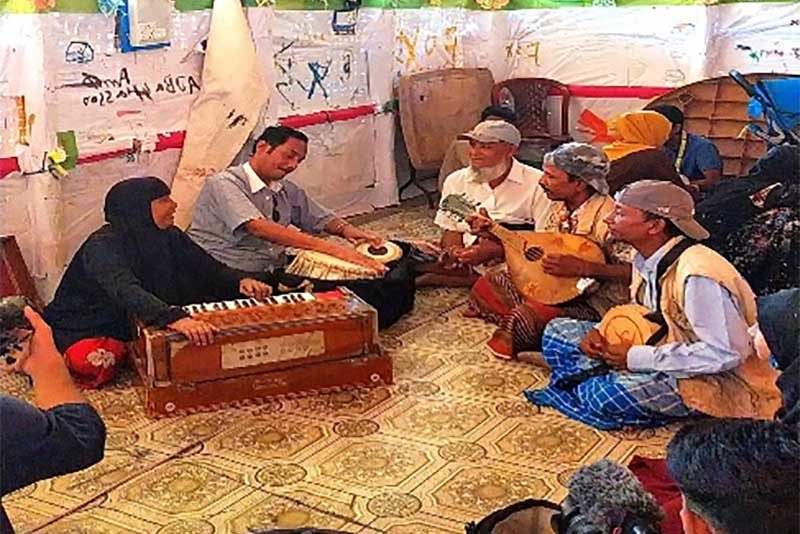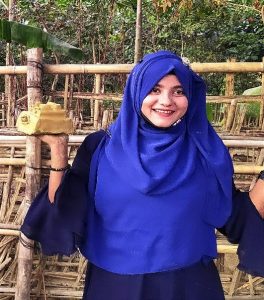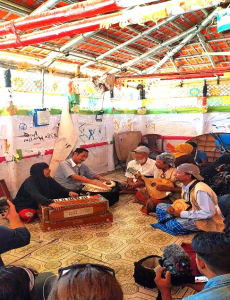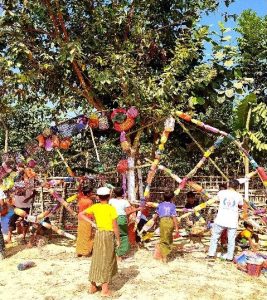
Creating meaningful visual communication through “Artolution”
Into Positive is creating meaningful visual communication through “Artolution” on their journey of collaborative art making. The target is to shoot three films on the Rohingya refugee camp, the artists expressing through beautiful art, the musicians narrating their history through music, and constructing sculptures out of plastic waste materials.
Artolution is a global Non-Profit organization focusing on the development of crisis-affected communities through diverse art. It brings out the history, heritage, and culture through the traditional work of mural making, tapestry, pottery, and many more. They want to send a message to the world about the untold suffering and pain of these communities.
Artolution is working in the Rohingya refugee camp to enhance the circumstances through their variation of art and sculpture, where they believe art speaks louder than mere words.

DILDAR BEGUM
Dildar Begum is a local Rohingya artist who was forced to leave her homeland and took shelter in one of the Rohingya refugee camps situated in Cox’s Bazar, Bangladesh. She is currently living in Balukhali camp, where she paints and teaches others to express their emotions through the strokes of brushes.
She is only 23 years old and is creating such beautiful masterpieces demonstrating their history and culture through tapestries, murals, and models made of clay that symbolize their heritage, which they are trying to preserve through the expression of art.
Her husband was killed brutally in Myanmar, leaving no other option for Dildar Begum and her family except to leave. She has been living with her family in a camp since 2017, where her brother, who stopped communicating after experiencing violence in Myanmar, has learned to communicate through art.
Dildar Begum is the symbol of empowerment. She rose from the ruins with her talent and devotion to her culture.

BULBUL AKHTER AND ROHINGYA MUSICIANS
Bulbul Akhter is a Bangladeshi singer, born and raised in the Chittagong region and currently living in Cox’s Bazar, Bangladesh. She is known for her music, which has touched the hearts of many admirers. She sings local, folk, Urdu, Hindi, and Ghazal.
Bulbul Akhter traveled to many places along Myanmar’s border and performed with her remarkable, sharp, bold voice, which created music that is now famous for her performance.
She is well-known among the locals for a song she sings in the style of the original singer. It goes like this:
“O hala chan golar mala,
Pet puredey tomar lai”
She visited the Rohingya refugee camp in hopes of coagulating a fusion of Bangladeshi-Rohingya music to present a remarkable diversity and make history.
The Rohingya musicians presented a type of music from their culture known as “Tarana,” using the beautiful instrument mandolin. Their music contains pain and suffering, what they went through, who they were, and what they want right now. Their culture is beautifully expressed through their music, asking for freedom and hoping their culture does not fade away.
This Bangladeshi-Rohingya music expresses that the border separates us, but music unites us. This signifies the importance and power of art and music in a community.

PEACOCKSTRUMENT
The sculping of a peacock using plastic wastes like bottles and household utensils defines recycled art. The peacock is a symbol of beauty and peace, and peacock songs were popular in Myanmar.
Multiple beautiful murals carried messages of empowerment, hope, and resilience. The colorful combination of dreams painted on the wall, portraits, traditions, and individuality.
Colorful tapestries, Nokshi-katha, miniature furniture made from bamboo, dolls and figures made from clay, clothes for babies, and hats made from scraps of clothing symbolize their culture.
They do not need much, just a handful of resources is enough for them to express their sentiment and love for their culture. The Rohingya children are learning something new every day. Communicating through art has been a success, from teaching them basic health hygiene to educating them on modes of expression.
This makes them happy, comfortable, and safe to be a part of this program, where they are free to feel, express, and dream. They dream of a better life, a better tomorrow.





